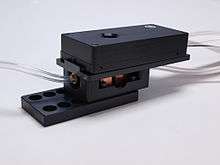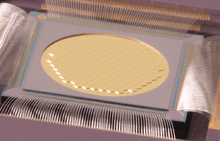Iris AO, Inc.
Iris AO, Inc. manufactures small-scale, microelectromechanical systems (MEMS)-based deformable mirrors (DM) and adaptive optics systems that offer radical advantages in cost, size, durability, flexibility, and power consumption. Iris AO systems make adaptive optics (AO) practical for a host of new applications, including astronomy, retinal and biomedical imaging, beam shaping, portable laser communications, and horizontal-path imaging.
| Industry |
|
|---|---|
| Founded | Berkeley, California, U.S. (2002) |
| Founder |
|
| Headquarters | Berkeley, California |
Area served | worldwide |
| Products | Customized MEMS products and standardized Deformable mirrors |
| Website | irisao.com |
History
Founded in June 2002 by Matt Campbell, Nathan Doble, Michael Helmbrecht, and Cliff Knollenberg, Iris AO manufactures advanced MEMS-based mirror products and high-voltage, high-channel-count drive electronics, adaptive optics (AO) controllers, and AO development systems.
Research and development
Iris AO is funded in part by research grants from NASA and the National Science Foundation (NSF). Iris AO develops new products for beam shaping, astronomy, retinal and biomedical imaging, portable laser communications, and horizontal-path imaging. Most recently, Iris AO developed a harsh-environment enclosure for its MEMS. This new upgrade consists of a water-cooling heatsink and a gas flow system to cool the surface of the deformable mirror. The availability of dielectric coatings (from 188 nm to 1600 nm), the harsh-environment upgrade, and the use of a variety of laser sources from deep UV excimer to ND:YAG lasers is positioning Iris AO as a leader in laser micro-machining and beam shaping.[1]


Applications
Fiber Coupling
The fibered pupil remapper instrument known as FIRST (Fibered Imager for Single Telescope) was recently installed on the Subaru Telescope in Mauna Kea. FIRST makes use of single-mode fibers to remove the effects of atmospheric turbulence by dividing the entrance pupil into sub-pupils that feed the fibers. The flux injection into the fibers is optimized by controlling an Iris AO PTT111 mirror (Huby et al. 2014).[2]
Beam Shaping
By inserting an Iris AO PTT111 MEMS deformable mirror-based adaptive optics system into the beam transfer optics of the 3m- C. Donald Shane Telescope at Mt. Hamilton, researchers actively controlled the wavefront of the outgoing laser guidestar beam. This uplink correction enabled correction of quasi-static aberrations, dynamic refocus of the laser guide star spot (LGS), and creation of a more compact reference beacon in the mesosphere (Norton et al. 2014).[3]
Exoplanet Detections
Iris AO DMs are used for wavefront correction in coronagraphs. For example, the Visible Nulling Coronagraph (VNC) at NASA Goddard is using the ultra-flat Iris AO PTT489 to demonstrate 10−9 contrast within 1-4λ/D over a 40 nm bandwidth centered at 633 nm (Hicks, et al. 2014).[4] A previous demonstration with the VNC achieved 5x10−9 contrast in narrowband polarized light (Lyon, et al. 2014).[5] This work opens the door for more technology developments aimed at imaging exoplanets with the next generation of space telescopes. Iris AO has improved the stability of its mirrors in extreme environments, as well as the accuracy of the segment controls (Aguayo et al. 2015).[6]
Products
| Model Number | PTT111-5 | PTT111-8 | PTT489-5 | PTT489-8 | [ PTT939-5] | [ PTT939-9] |
| Number of Actuators | 111 | 489 | 939 | |||
| Number of Segments | 37 | 163 | 313 | |||
| Max Stroke | 5 μm | 8 μm | 5 μm | 8 μm | 5 μm | 8 μm |
| Max Tilt Angle | ±4 mrad | ±6.4 mrad | ±4 mrad | ±6.4 mrad | ±4 mrad | ±6.4 mrad |
| Min. Frequency Response | 2 kHz | |||||
| Inscribed Aperture | 3.5 mm | 7.7 mm | 10.85 mm | |||
| Optical Coating | Protected Silver, Gold, Protected Aluminum; Optional Dielectric Coatings | |||||
| Mirror Type | Segmented, piston/tip/tilt | |||||
Mirrors are sold with factory-calibrated Smart Driver II drive electronics. Many projects and deformable mirrors are customized for specific applications.[7]
Management
- Michael Helmbrecht, Ph.D. CEO, Founder
- Marc Besse, Senior Software Architect
- Pamela Caton, Ph.D. Senior MEMS Engineer
- Min He, Ph.D. Senior MEMS Processing Engineer
- Carl Kempf, Ph.D. Senior Systems Engineer
- Franck Marchis, Ph.D. Senior AO Application Scientist
Awards
See also
References
- Iris AO, publications. “”
- Huby et al. (2014) "http://spie.org/x108976.xml"
- Norton et al. (2014) "http://spie.org/Publications/Proceedings/Paper/10.1117/12.2055564"
- Hicks, et al. (2014) "http://proceedings.spiedigitallibrary.org/proceeding.aspx?articleid=1894815"
- Lyon et al. (2014) "http://proceedings.spiedigitallibrary.org/proceeding.aspx?articleid=1894893&resultClick=1""
- Aguayo et al. (2015) "http://proceedings.spiedigitallibrary.org/proceeding.aspx?articleid=1894893&resultClick=1"
- Helmbrecht et.al (2011) “”